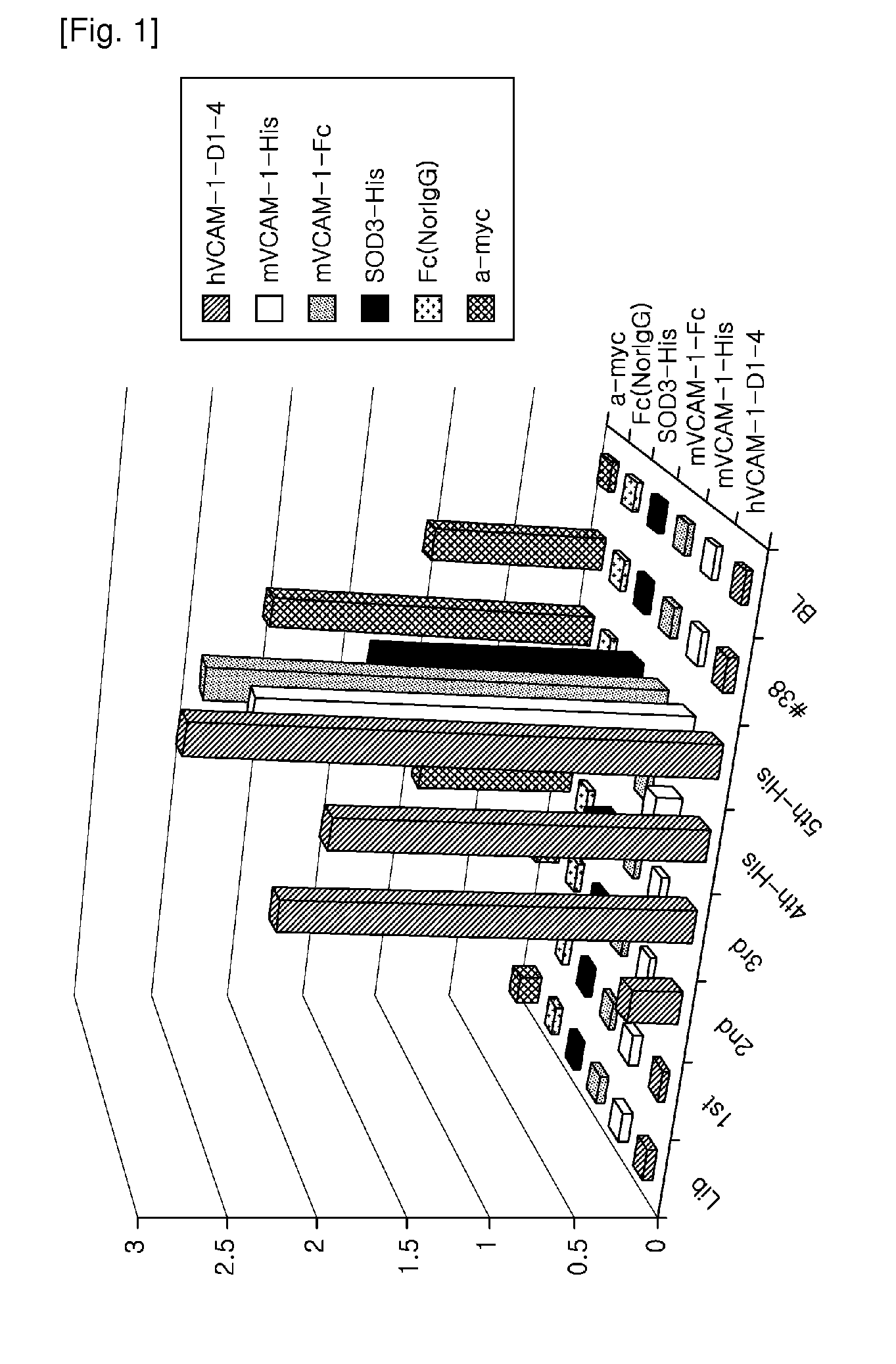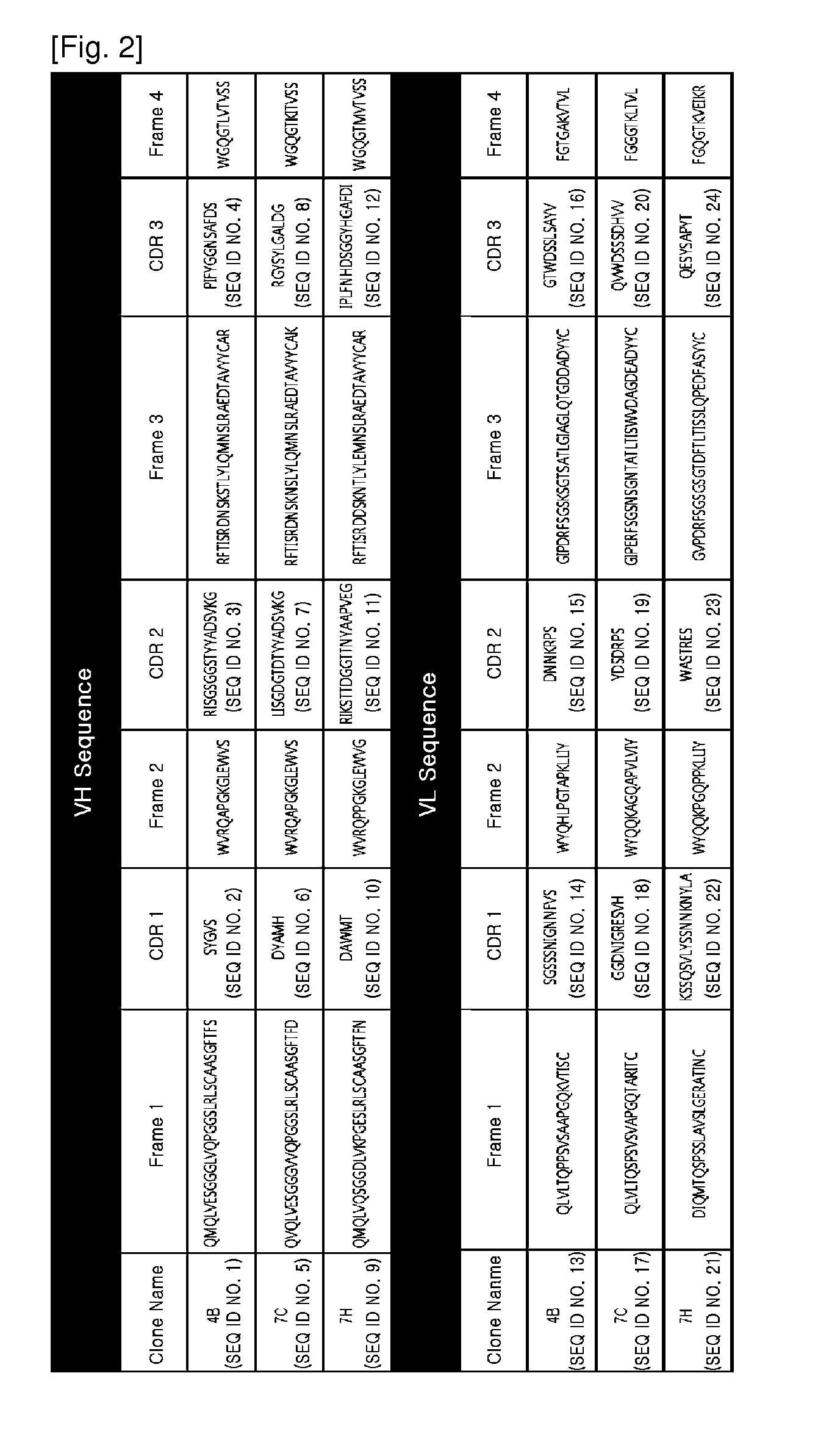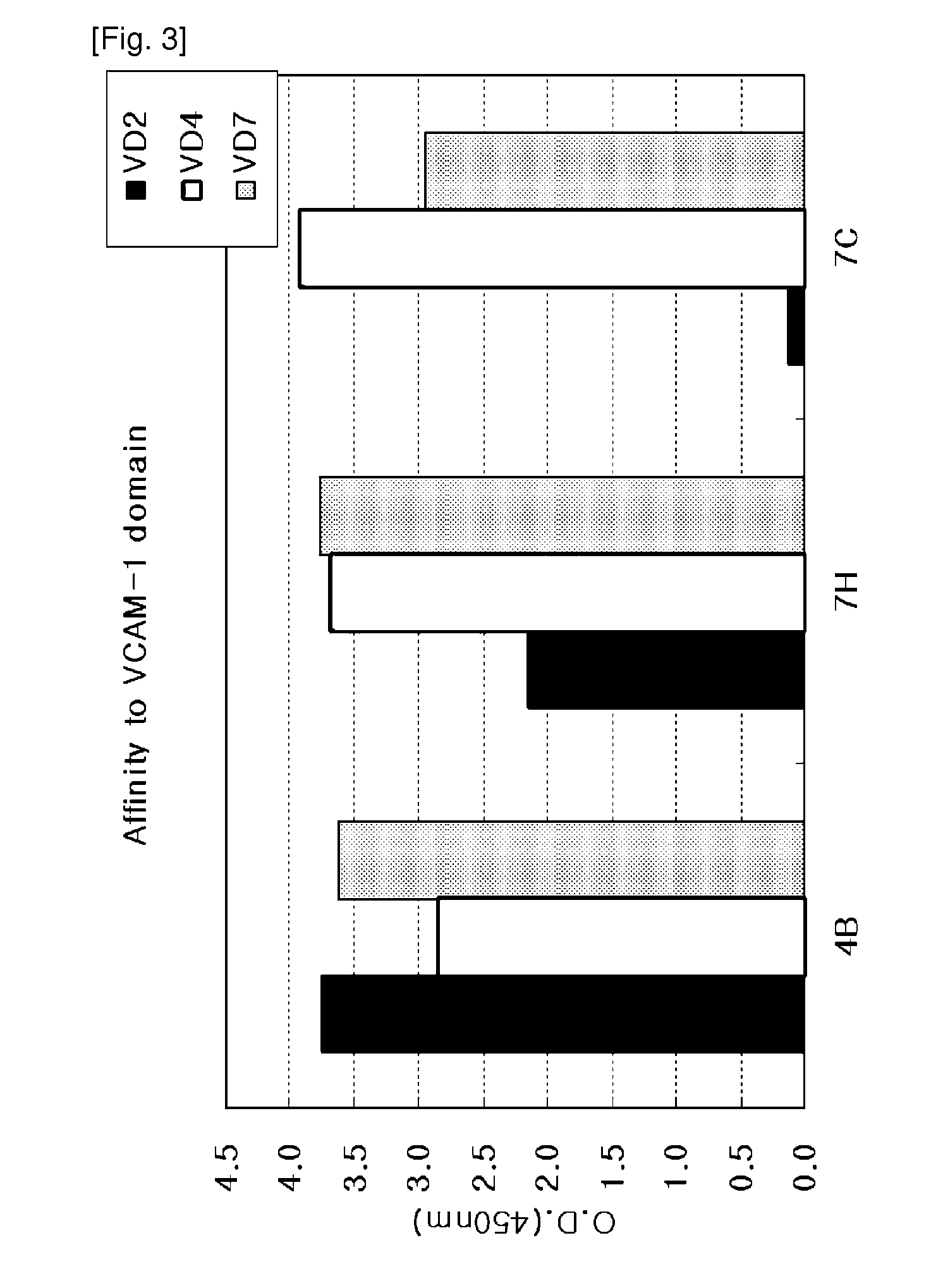Human monoclonal antibody that specifically binds to vcam-1 and a composition for treating an inflammatory disease or a cancer comprising the same
a monoclonal antibody and inflammatory disease technology, applied in the field of human monoclonal antibodies, can solve the problems that the development of a neutralizing antibody to vcam-1 has not been actively studied, and achieve the effects of low immunogenicity, strong affinity, and effective inhibition of leukocyte adhesion
- Summary
- Abstract
- Description
- Claims
- Application Information
AI Technical Summary
Benefits of technology
Problems solved by technology
Method used
Image
Examples
example 1
Preparation of Human and Mouse VCAM-1 Antigen
[0068] Cloning of Human VCAM-1
[0069]A plasmid containing human VCAM-1 gene (hMU012650) (Kugi # IRAU-75-G02) was purchased from KUGI (Korean UniGene Information) provided by the Center for Functional Analysis of Human Genome, Korea Research Institute of Bioscience and Biotechnology (KRIBB). The plasmid was used as a template DNA, and in order to express only the D1-D2 domain and D1-D4 domain of VCAM-1, each gene was amplified using a forward primer (5′-CAGGGGGCCGTGGGGGCCTTTAAAATCGAGACCACCCC-3′, SEQ ID NO. 25) and a reverse primer (5′-TAGCGGCCGACGCGGCCAATTGCAATTCTTTTACAGCCTG-3′, SEQ ID NO. 26) for the D1-D2 domain of VCAM-1, and a forward primer (5′-CAGGGGGCCGTGGGGGCCTTTAAAATCGAGACCACCCC-3′, SEQ ID NO. 27) and a reverse primer (5′-TAGCGGCCGACGCGGCCAAGAGCTCCACCTGGATTCCCT-3′, SEQ ID NO. 28) for the D1-D4 domain of VCAM-1. After treatment of sfiI, a ligase was used to clone the genes into a pYK602-Fc vector and a pYK602-His only vector (vector...
example 2
Construction of Library Phage
[0073]2.7×1010 human scFv (single-chain variable fragment) library cells having diversity were cultured in a medium (3 L) containing 17 g of 2×YTCM [Tryptone (CONDA, 1612.00), 10 g of yeast extract (CONDA, 1702.00), 5 g of NaCl (sigma, 57653-5 kg), 34 μg / Ml of chloramphenicol (sigma, C0857))], 2% glucose (sigma, G5400) and 5 mM MgCl2 (sigma, M2393) at 37° C. for 2-3 hrs (OD600=0.5˜0.7). Thereafter, the cells were infected with helper phage, followed by culture in a medium containing 2×YTCMK [2×YT CM, kanamycin (sigma, K1876) 70 μg / Ml, 1 mM IPTG (ELPISBIO, IPTG025)] at 30° C. for 16 hrs. The cells proceeded to centrifugation (4500 rpm, 15 min, 4° C.) and supernatant was obtained, which was dissolved in a solution supplemented with 4% PEG (Fluka 81253) 6000 and 3% NaCl (Sigma S7653), followed by reaction in ice for 1 hr. The reactant was centrifuged again (8000 rpm, 20 min, 4° C.). The pellet was dissolved in PBS, which proceeded to centrifugation again (1...
example 3
Panning by Phage Display
[0074]When VCAM-1 consisting of seven IgG-like domains binds with its ligand, alpha4beta1 integrin (α4β1 integrin), its domains 1 and 4 are known to function as a binding motif. Thus, panning was performed using human VCAM-1-D1-D4 (hVCAM-1-D1-D4) as well as the entire VCAM-1 molecule. In this Example, the panning method and result for hVCAM-1-D1-D4 will be described.
[0075] Panning on hVCAM-1-D1-D4
[0076]An immunosorb tube (Nunc 470319) was coated with 30 μg of hVACM1-D1-D-His antigen using 4 Ml of coating buffer [coating buffer; 1.59 g of Na2CO3 (sigma, S7795), 2.93 g of NaHCO3 (sigma, S8875), 0.2 g of NaN3 (sigma, S2002)] at 4° C. for 16 hrs with a rotator. Then, the antigen was dissolved in PBS at room temperature for 2 hrs, followed by blocking in the immunotube using skim milk [(BD, 232100)—4% in 1×PBS]. 2 Ml of the prepared library phage was added to the immunotube, followed by reaction at room temperature for 2 hrs. The immunotube was washed 5 times with...
PUM
| Property | Measurement | Unit |
|---|---|---|
| Fraction | aaaaa | aaaaa |
| Angle | aaaaa | aaaaa |
| Nanoscale particle size | aaaaa | aaaaa |
Abstract
Description
Claims
Application Information
 Login to View More
Login to View More - R&D
- Intellectual Property
- Life Sciences
- Materials
- Tech Scout
- Unparalleled Data Quality
- Higher Quality Content
- 60% Fewer Hallucinations
Browse by: Latest US Patents, China's latest patents, Technical Efficacy Thesaurus, Application Domain, Technology Topic, Popular Technical Reports.
© 2025 PatSnap. All rights reserved.Legal|Privacy policy|Modern Slavery Act Transparency Statement|Sitemap|About US| Contact US: help@patsnap.com



